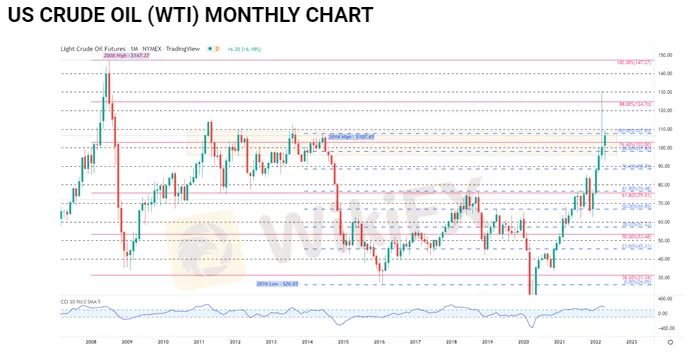简体中文
繁體中文
English
Pусский
日本語
ภาษาไทย
Tiếng Việt
Bahasa Indonesia
Español
हिन्दी
Filippiiniläinen
Français
Deutsch
Português
Türkçe
한국어
العربية
Crude Oil Remains Conflicted by Key Technical Levels
Abstract:Following the invasion of Ukraine in late Feb, oil prices have continued to soar, with both WTI and Brent finding support above the $100 p/b (per barrel) mark.
CRUDE OIL PRICE ANALYSIS:
Oil prices remain supported by further supply constraints but key technical levels hold firm
US Crude (WTI)aims to clear the $110 psychological handle but will bullish momentum prevail?
Price actionremains encapsulated between Fibonacci levels of historical moves
{{GUIDE|OIL|}}
OIL TECHNICAL & FUNDAMENTALS COLLIDE
As condemnation against the Kremlin continues to rise, the embargo against Russian energy and gas from Western allies and European counterparts (including Germany, one of the primary importers of Russian energy) has exacerbated concerns that inflationary pressures may continue to mount.
US CRUDE OIL (WTI) TECHNICAL ANALYSIS
Although fundamental factors are likely to remain as a prominent driver of price action, the monthly chart below highlights how key technical levels from historical and short-term moves have assisted in providing firm levels of support and resistance for price action, holding both bulls and bears at bay.
After rising above the 2014 high of $107.65 in early March, failure to gain traction above $120 enabled sellers to drive prices lower, before stabilizing around the $100 handle.
With both key psychological and Fibonacci levels currently in play, the monthly CCI (commodity channel index) remains in overbought territory, suggesting that although the uptrend remains intact (for now), bulls may be losing steam.

While inflation currently remains at decade highs, supply constraints have been exacerbated by the ongoing conflict between Russia and Ukraine, providing an additional catalyst for price action.

As prices continue to whipsaw between the Fib levels of both the historical (2008 – 2020) and 2014 – 2016 move, the $94 - $108 range will likely continue to hold firm with a break towards either side increasing the probability of a breakout.
In order for upward trajectory to hold, bulls will need to conquer the $108 and $110 level, with the next level of resistance holding firm at $116,58 (the 14.4% Fib of the 2008 – 2020 move). If this level is broken, a break of the psychological $120 mark could leave the door open for a retest of the 2022 high at $130.5.

However, for bearish momentum to gain traction, sellers would need to drive prices below $100 which could then bring $93.56 (the 38.2% retracement of the Nov 2020 – 2022 move) into play. If prices continue to fall below $90.00 and $88.39 (23.6% Fib of the 2014-2016 move), it is possible for WTI to retest $80.00.

Disclaimer:
The views in this article only represent the author's personal views, and do not constitute investment advice on this platform. This platform does not guarantee the accuracy, completeness and timeliness of the information in the article, and will not be liable for any loss caused by the use of or reliance on the information in the article.
Read more

BaFin Issues Warning Against Clone Broker Exploiting Pepperstone's Identity
The German Federal Financial Supervisory Authority (BaFin) has recently flagged a fraudulent clone of the licensed retail FX and CFD broker Pepperstone. This fake entity, operating under the domain pepperstone.life, has been offering financial and investment services without obtaining the necessary regulatory authorisation.

TikTok: A Rising Hub for Investment Scams in Malaysia
The Royal Malaysian Police (PDRM) have raised concerns over the increasing use of TikTok by criminal syndicates to lure victims into investment scams.

Webull Canada Expands Trading Hours with Options Trading
Webull Canada now offers extended trading hours from 4 a.m. to 5:30 p.m. ET, plus options trading. Gain flexibility and manage risk in an ever-changing market.

Webull and Others Fined $275,000 for Incomplete Suspicious Activity Reports
Webull Financial, alongside Lightspeed Financial Services Group and Paulson Investment Company, LLC, has agreed to pay a collective fine of $275,000 following an investigation by the US Securities and Exchange Commission (SEC). The penalty was issued due to the firms’ failure to include essential information in suspicious activity reports (SARs) over a four-year period.
WikiFX Broker
Latest News
Saxo & Portuguese Bank Partnership
SEC Fines Broker-Dealers $275K for Incomplete SAR Filings
Elon Musk Warns of Imminent US Bankruptcy | Bitcoin Retreats from $100K
WikiEXPO Global Expert Interview: Advanced Practices and Insights in Financial Regulation
Justin Sun Invests $30M in Trump-Backed World Liberty Financial
Kraken Closes NFT Marketplace Amid New Product Focus
Robinhood Launches Ethereum Staking with 100% Rewards Match
Lured by False Promises: Malaysian Driver Lost RM218K to an Investment Scam
FTX Sets March 2025 Timeline for Creditor Payouts: What It Means for Investors
What is an Economic Calendar? How it works
Currency Calculator



